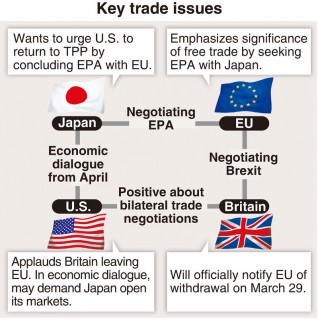Loading
Search
▼ Japan, EU Look to Free Trade Amid Headwinds
- Category:Event
BRUSSELS — Prime Minister Shinzo Abe met European Council President Donald Tusk and other European Union leaders in Brussels on Tuesday, where they reaffirmed their goal to quickly conclude a broad agreement on an economic partnership agreement.
Protectionist movements are gaining momentum worldwide, as seen in U.S. President Donald Trump’s desire to give favor to domestic industries and Britain’s decision to leave the EU. Japan and the EU, however, are looking to show their stance of promoting free trade by concluding the EPA.
Abe stopped in Brussels for only four hours to meet with Tusk and European Commission President Jean-Claude Juncker. With the leaders of several major countries scheduled to meet in Italy in May, Abe wanted a mutual confirmation of “the importance of free trade,” according to a source close to the prime minister.
The previous day, Abe met with French President Francois Hollande and agreed to seek an early general agreement in the Japan-EU EPA negotiations. The two leaders’ shared view on the significance of free trade had in mind the United States, which withdrew from the Trans-Pacific Partnership trade pact and suggested it could impose de facto import restrictions.
A Japan-EU EPA would create a huge free-trade bloc comprising 30 percent of the world’s gross domestic product. U.S. manufacturers and farmers would be at a disadvantage to EU companies when trying to enter the Japanese market.
Japan hopes that by quickly wrapping up the EPA negotiations, it can press the United States to come back to the TPP.
The EU is facing Britain’s exit, or Brexit, so concluding an EPA with Japan would be a positive achievement.
EU officials hope that as negotiations over Brexit get under way, it can emphasize the benefits of expanding exports to Japan, which could help unite other EU nations and discourage any other members from leaving.
However, gaps remain between Japan and the EU, mainly in the agricultural and automotive sectors.
Japan wants the EU to immediately abandon the 10 percent tariff it places on Japanese vehicles, while the EU is seeking the repeal of Japanese duties on cheese and other processed agricultural products. Japan places high tariffs on imported cheeses to protect domestic dairy farmers.
The initial goal was to reach a broad agreement last year. The EU has shown it is willing to wait for Japan to make concessions, so the focus now is on how far Japan and the EU will come to a compromise.
The United States sees its large trade deficit as a problem and has adopted a strategy of seeking better conditions through bilateral trade negotiations, rather than in multilateral pacts.
Yet much is still unclear about Trump’s trade policies, which have been affected by slow approval of his Cabinet nominees.
Still, at a meeting in Germany on Saturday of finance ministers and central bank chiefs from the Group of 20 economies, compromise could not be reached with the United States, which is now emphasizing a trade structure that puts “America first.” In the joint statement released after the meeting, language opposing protectionism had disappeared.
Japan is scheduled to enter into a wide-ranging economic dialogue with the United States in April, covering themes from trade to financial and fiscal policy. Japan faces a test as to whether it can push the United States to seek freer trade while speeding up the EPA negotiations with the EU.
- March 23, 2017
- Comment (1)
- Trackback(0)



riddle arena Web Site- 15/11 15:57